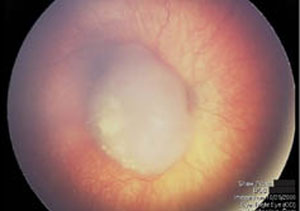 |
|
Retinoblastoma patients may fare better from enucleation than eye-preserving therapies. Click image to enlarge. |
While frontline treatment with intravenous chemotherapy combined with focal treatments has been helpful in salvaging eyes in Groups A, B and C of retinoblastoma, it remains controversial to apply ocular salvage treatment to eyes belonging to Groups D and E. A team of Chinese researchers performed a multicenter study covering all 31 provinces of the Chinese mainland and found that patients’ lives may be risked if enucleation is delayed by attempts to cure high-risk eyes. Chemotherapy before enucleation of Group E eyes increased the risk of metastatic death, they noted.
The team reviewed medical charts of 1,678 patients diagnosed with Groups D or E retinoblastoma from January 2006 to May 2016 from 38 retinoblastoma treatment centers. In this cohort, 1,172 (70%) patients had unilateral retinoblastoma and 506 (30%) had bilateral retinoblastoma.
In unilateral retinoblastoma patients, 49% had primary enucleation and 51% had eye-preserving therapies initially. During the follow-up (median: 45.6 months), 59 (10%) patients from the primary enucleation group and 56 (9.3%) patients from the eye-preserving group died. Analysis indicated no significant difference in overall survival rates between the two unilateral groups.
For the bilateral patients, only 19% of eyes had primary enucleation, while 81% had eye-preserving therapies initially. During follow-up (median: 40.1 months), 12 (13%) patients from the primary enucleation group and 69 (17%) from the eye-preserving group died. The researchers noted that bilateral retinoblastoma in the worse eye of Group E patients who had primary enucleation exhibited better overall chances of survival (hazard ratio: 2.35).
Unfortunately, the cause of death could not be exactly allocated for each patient in the study. Among the 150 patients with a confirmed cause of death, 143 died of metastatic retinoblastoma. The sites of metastasis included the central nervous system in 132 patients.
“On the whole, primary enucleation led to a lower mortality rate for bilateral patients with the worse eye of Group E,” the investigators noted. “However, the first 22.6 months after initial diagnosis seems to be the ‘risk period’ for them, and if they could live beyond this time, the survival advantage brought by primary enucleation is prevailing over initial eye-preservation.”
The team also suggested that limited public awareness of the importance of early detection, poor understanding of the high quality of life after unilateral enucleation and unanticipated economic and psychological burdens brought by conservative management might contribute to the overestimated global salvage rate, especially in bilateral retinoblastoma. Therefore, clinicians should carefully weigh the choice of primary treatment for advanced retinoblastoma.
Zhou C, Wen X, Ding Y, et al. Eye-preserving therapies for advanced retinoblastoma: a multicenter cohort of 1,678 patients in China. Ophthalmology. September 15, 2021. [Epub ahead of print]. |

